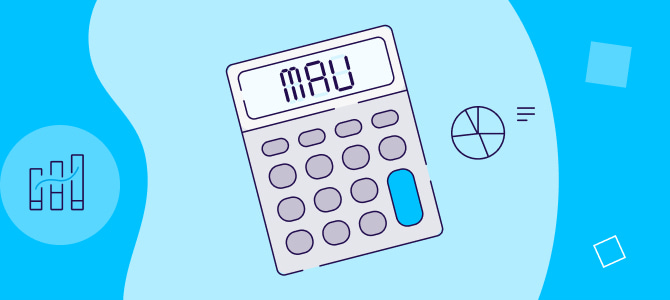
Monthly Active Users (MAU)
The number of unique users that engage with your app within a 30-day window. Unlike daily active users (DAU), MAU is typically used by traveling or financial apps where users are expected to interact a few times a month or less (e.g. banking apps).
What is MAU?
MAU is a metric commonly used to identify the number of unique users who engage with an app or website within a predefined 30-day period. Brands usually monitor MAU by using a unique identifier such as a user ID, a username or email.
How a brand defines an active user can vary according to their vertical or business needs. To give you a more meaningful insight into how your users are engaging with your app, MAU needs to be analyzed in relation to DAU.
To fully understand what MAU means, let’s go ahead and dive further into the three components that determine MAU:
- Users – when calculating MAU, a user has to perform some sort of in-app action during a 30-day period – be it logging in, completing a specific action, or performing a certain number of actions. A unique user is counted once regardless of how many times they have logged in.
- Action – which actions qualify a user as a MAU? This is completely up to your business to define. In most cases, a MAU opened the app or logged in, which allows for easier measurement and comparison.
- Time frame – here we’re looking at either the last month or the 30 days leading up to a certain event.
How to calculate MAU

Calculating MAUs could be regarded as deceptively simple, but it can become more complicated depending on how your activity is defined.
To get you started, begin with the following steps:
- Define your criteria for an active user – While a simple log-in is easy to measure, it doesn’t give you a lot of information about whether that user actually used your app or not.
As such, a more useful definition would be a user that performed a specific in-app action. The less precise your definition of an active user is, the more fuzzy the data will be when MAU grows or shrinks.
- Define the frequency of engagement you’re looking to measure (MAU in our case).
- Collect the data using your analytics tool of choice, and sum the number of unique users who meet your active user criteria for the selected day, and then month. It’s important to remember that our goal here is to measure unique users only.
Why should you monitor MAU?

From a growth standpoint, you have to be able to gauge how users interact with your app. A high MAU usually indicates a good rate of app engagement and positive retention over a period of time.
Measuring MAU allows you to better assess the efficiency factor of your marketing strategies and customer experience, which makes it one of the indicators for your app’s general health.
When coupling MAU with other engagement-related metrics, it can offer a way of evaluating:
- App engagement
- Success rates of specific marketing campaigns (user acquisition)
- Retention rate
- Churn rate
- Growth rate – current and potential
- Revenue growth rate – current and potential
MAU can also be the basis for other metrics, such as lifetime value (LTV) and cost per action (CPA). Above all, MAU can give you an indication of your app’s perceived value.
And we use the word “can” because there are lots of other important factors that tie into your app’s value – such as installs, average revenue per user (ARPU), retention, churn, and purchase frequency – to name a few.
DAU/MAU ratio
When paired with DAU, the DAU/MAU ratio allows you to measure the relative volume of monthly active users who engage with your app over a 24-hour time period.
Using this formula, you can forecast traction and potential revenue over time. But even more importantly – this ratio helps you determine the value of your product for your users by measuring how often they return to your app.
Here’s how it’s calculated:

And here’s a practical example:
Let’s say you had 2,000 DAUs and 8,000 MAUs during the month of August. Your stickiness ratio for that month would be 25%.
That’s a very happy place to be in, by the way. A stickiness average of 20% across industries is considered good, while 25% and beyond is considered exceptional.
The limitations of MAU
MAU is relatively easy to calculate, but it does come with its own set of limitations. Here’s a brief overview of the main four:
1. Lack of industry standardization
This is one of the key limitations when relying on MAU for comparative success. Since every company relies on its own terminology and even methods to calculate MAU, it can be challenging – some would even argue it would be deceptive – to use MAU for a meaningful comparison.
The fact that there are no uniform standards for the individual components of MAU makes it somewhat of an elusive target.
2. MAU is an unreliable metric if you’re a very young business
Putting too much emphasis on MAU early into launching a new app is problematic, to put it lightly. Given the very definition of MAU, all of the promotional activities that are associated with an app launch – like paid ads, social media campaigns, etc. – can all inflate MAU figures dramatically, without reflecting a true trend that’s indicative of a steady growth. Instead, it would be better to assess MAU once traffic has normalized over a few months.
3. Depth of usage is not measured
Logging into an app doesn’t necessarily entail engagement. From a monetization point of view, you can only monetize users who engage with your app, which makes MAU a slightly superficial metric when being viewed as a standalone figure.
4. Quality of users is not measured
Not all users were created equal. Different media sources tend to produce different users with different engagement behaviors. While some regional campaigns may yield lots of fast installs, the users associated with that source may exhibit poor engagement or lead to a sudden spike in churn.
So although MAUs for a specific campaign might seem massive, the value of the acquired users could be sub-par, with a damaging potential in terms of brand reputation, app store score, social media reviews, and overall customer satisfaction.
How can you increase MAU?

A winning app engagement strategy has to encompass multiple channels like email, push notifications, in-app notifications, and re-engagement campaigns.
How do you harness all these channels into ramping up MAU rates? Here are a few tips and pointers:
1. Push notifications
Despite being one of the most effective ways to engage your app users, if misused, push notifications are also one of the quickest ways to generate uninstalls.
So how often should you send push notifications to your users?
There are plenty of sources out there to provide you with best practices and benchmarks, but the most important thing would be to ask yourself: Am I offering actual value to my audience?
Push notifications should never be about quantity, but about improving your users’ experience using personalized and relevant communication.
To help your MAU numbers go up, keep an eye out for your push notification statistics, which will help you determine what works – and especially what doesn’t.
2. In-app messages
The more aligned your app experience is with your users’ needs and preferences, the more likely they are to continue using your app.
In fact, recent research shows that brands using personalized in-app messages experience retention rates of 61% to 74% within 28 days of receiving the message. On the flip side, brands that blast off mostly generic campaigns see retention rates cap out at 49% within 28 days.
Generally speaking, in-app messages are not intended for communicating immediate calls to action, but are nonetheless important notifications to receive. They can include warnings about app issues, payment failures, or version upgrades.
To ensure maximal relevance, it’s best to segment your audience based on regions, preferences, usage or history, using tailored messages that include real-time updates and links to personalized content.
3. Email / SMS
Retention comes down to being able to serve users well and keeping your app top of mind so that they’ll come back to it again and again.
After downloading your app, it might take your users some time to tap into its full potential. Keeping in mind that onboarding is a continuous process, sending your newly embarked users the occasional email is a good way to maintain high DAU rates.
For example, email could be used to target users that were once active but have since kept their distance. It’s the least intrusive way to say “We miss you. Here are some exciting updates you might find useful”.
In the case of content apps, a user who was once active for 7 days straight but then didn’t open the app in 3 days – might appreciate an email with a link to an in-app trending article.
Proper audience segmentation could mean the difference between an idle to an engaged user.
4. Deep linking
So you’ve crafted the perfect email with an irresistible offer to redeem a special coupon. It’s personalized, it’s contextual, and it’s extremely relevant. That’s great. But then when clicked – it directs your users to your app’s general home screen. Not so great.
Attribution-fueled deep linking is at the heart of a true cross-channel strategy. By linking your siloed channels into one cohesive user experience platform, it ensures a consistent, hassle-free user experience, and enables your users to float through their user journey effortlessly.
Not only does deep linking help you to remove as many obstacles along the user journey as possible, but it also allows you to build a long-lasting relationship with your users, and strengthen your competitive edge.
It has proven itself time and again to be an easily executed strategy well worth implementing.
Key takeaways
- In the app world, an active user is most commonly regarded as a user logging into their account. However, the various types of engagement that make up an active user can differ between business sectors and business goals.
- Determining the number of your active users over time helps you to assess the effectiveness of your campaigns, and the customer experience your app delivers.
- MAU discloses only the quantity of users, not their quality. In many cases, only a small portion of your MAU users will generate the most value, while some if not most will use your app frequently.
- Despite the fact that variations in the very definition of an active user can make it difficult to compare brand success, when combined with other metrics – MAU does offer insights into a business’ app engagement, user acquisition, retention rate, churn rate, and growth rate.





